Good Things Take Time Pt. II: From Vision to a Beloved Christmas Classic
With a few publishing hiccups!
Welcome Back to Our Christmas Series on Klaus!
Yesterday, we talked about how persistence and the right conditions can bring great ideas to life. Today, we’re peeling back the curtain on what made Klaus such a remarkable creation.
This Series is called “Good things take time” for a reason! It took Sergio Pablos 10 years to get it out of the drawer, into a 2 minute teaser that got the hype of the movie industry, to eventually have Netflix collaborate with them (aka help pay for the movie).
Haven’t read it, yet? Then here’s yesterday’s post!
In today’s post, we’ll explore:
Why 2D animation requires extraordinary patience
How the story and characters were reworked over and over until they clicked
The groundbreaking technology created just for Klaus
How they pitched the project to get funding from Netflix
10 years! That’s more or less how long it took. So…
Why Did Klaus Take So Long to Make?
Creating Klaus wasn’t about following a recipe for doing a goulash or a spaghetti Bolognese. It also isn’t the same as “just” giving characters a script and having actors “do their thing” while you film it. 2D animation has to be hand-drawn, animated… you need to understand how the characters have to react, talk, move, and also define how the “camera” (your eyes) will see the point of view. How is the story being told?
So in this case, Klaus needed a lot of creation, innovation and resourcefulness.
Let’s break down the key reasons this film took nearly ten years to create:
1. 2D Animation Requires Patience
Hand-drawn animation is a frame-by-frame labor of love! Every motion, shadow, and facial expression has to be sketched and polished by hand. Sergio Pablos was deeply committed to ensuring Klaus would honor the beauty of 2D animation.
But patience wasn’t just needed for the artistic process—it was embedded in every stage of the project. As Pablos said, “Being a good animator doesn’t mean you’re a good director. It takes time.”
At the same time, imagine, to tell the story of a town, you need characters… a lot of them. All of them should be cohesive with the overall plot, as well as the vision for it, and be cohesive throughout the movie.
Torsten Schrank was, at some point, the reason behind the movie to see the light of day. According to Sergio Pablos, Tor was behind almost all of the 290+ character designs in the movie: he didn’t design all of them and their poses, but he designed the majority of the characters’ bodies, and how they should look like, so the team could replicate it throughout the scenes.
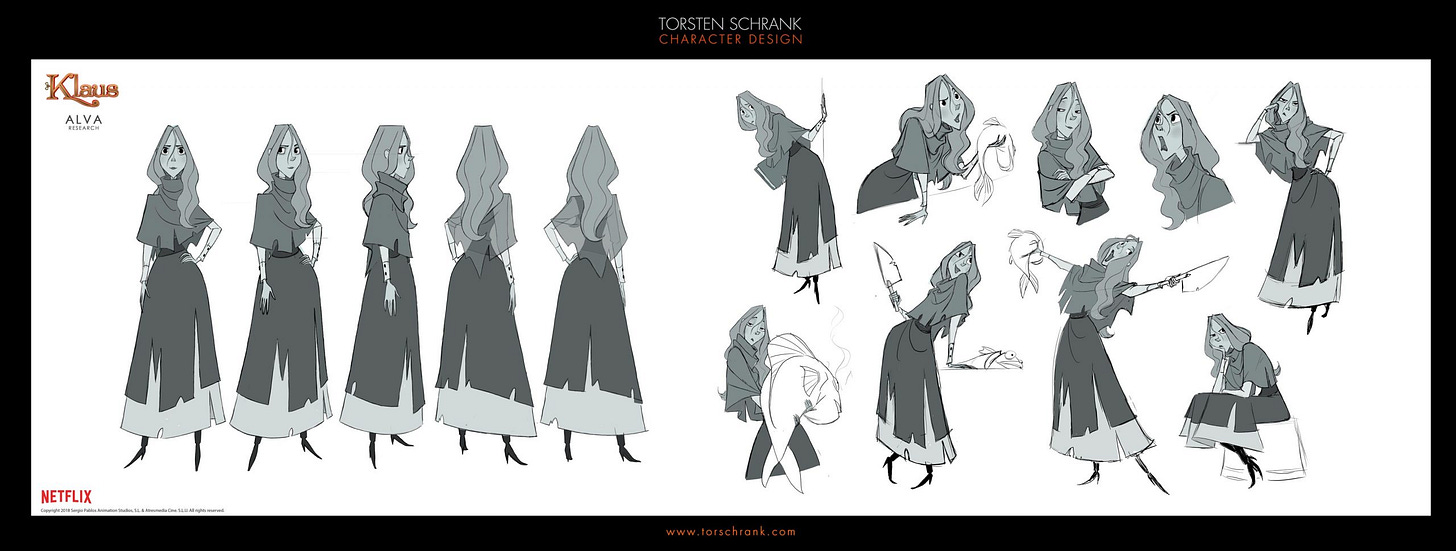

2. Multiple Endings, Beginnings, and Iterations
The story of Klaus didn’t fall into place overnight. The team explored countless variations of the plot: alternate openings, endings, and story arcs. And even characters!
Alternate beginnings, you might ask? Yes! Jesper wasn’t supposed to be rich! He wasn’t supposed to be the son of a Royal Postmaster General, who lived a very wealthy, comfortable life in the beginning of the movie. They had designed it to be a poor character, depressed about life, a bit like Aladdin in the beginning of his movie, dreaming of a better life for himself, wondering how it’d be to live in a castle. But after seeing it, Pablos and his team decided that it wasn’t… clicking. So they went back to the drawing boards.
You can see more about it here, if you want: Jesper… the poor, chimney cleaner. How he’d get to become the man behind Klaus’ return to toy-making, I have no clue, but I’m glad they changed it mid-through the movie-making process!
Even other characters need iteration, experimentation, to see what works well, what aligns with the vision, the plot and the story! Look at how many Margus they drew until they understood which one to go for. Margu is supposed to be a typical little Saami girl, very cute and easy to like, someone you should “fall in love due to her cuteness” very easily. So they needed to try out different designs until they could land on Margu (the end result!):
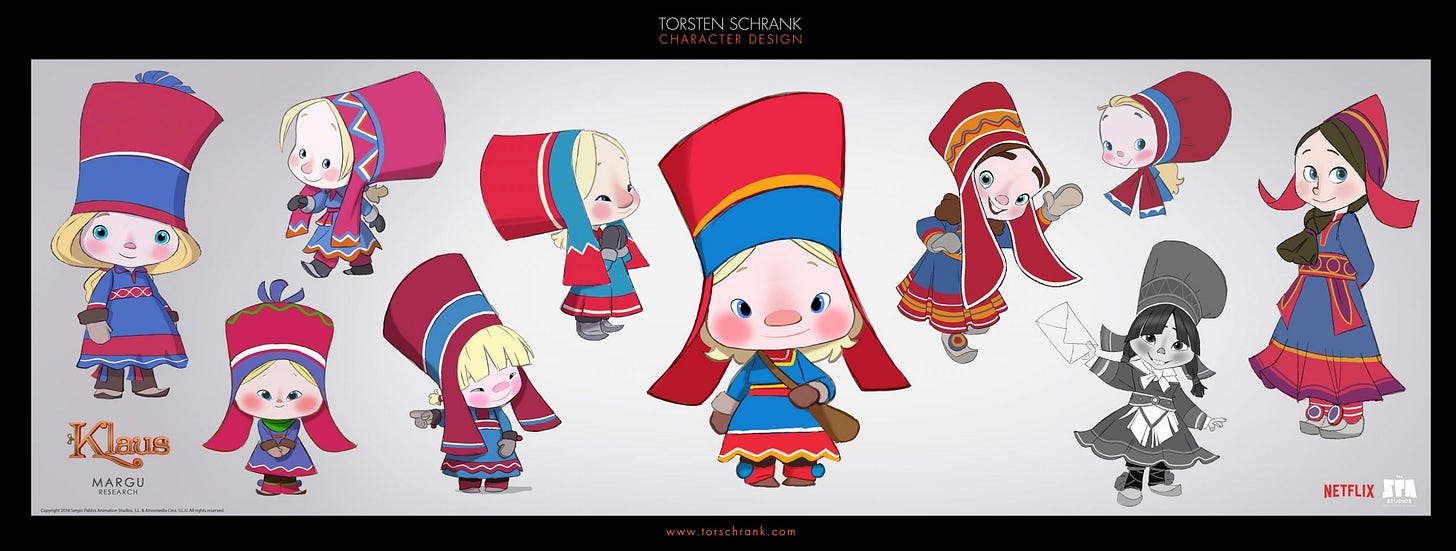
Sergio Pablos’ valuable lesson on character design (that you can apply in your own line of work?): Your first, second, and even third ideas (or sketches) won’t make it. But without them, you won’t find the one that will.
The creators were determined to find the perfect balance between humor, heart, and timelessness, so that’s why they drew and redrew things so many times!
3. Building New Technology for a Vision
One of the most revolutionary aspects of Klaus is its visual style. To achieve this, the team at SPA Studios developed KLaS with Les Films du Poisson Rouge, creating their own software with specific brushes and features, they called KLAS: Klaus Light and Shadow. This custom lighting tool gave the 2D animation a depth and texture typically reserved for 3D CGI.
Creating this technology was no small feat.1 In an interview, Marcin and Jakubowski said:
“Once the movie is released, we hope this approach will be adopted by others. It’s not that it’s completely revolutionary: Marcin created the proof-of-concept video using existing software, which wasn’t even suited for this kind of task. He had to work around limitations to achieve his vision. This isn’t about inventing new technology but rethinking how lighting and texture are used. In that sense, it’s groundbreaking.
When Sergio first pitched the artistic concept, Szymon didn’t believe it was possible. He thought, “That’s a nice dream, but what you’re asking for is impossible.” And yet, here we are.”
To me, this is an amazing example of intrapreneurship, the whole purpose of this publication, and the newsletter you’re reading: Innovation from Within! KLaS allowed animators to blend traditional hand-drawn artistry with cutting-edge shading techniques, resulting in a visual style that feels both nostalgic and innovative.
Here’s a bit of a step by step out of the 21 minute-long video where Florian Aupetit, responsible for Lighting, narrates how and what he’s doing it:

4. Nothing can get made without money… not your ideas at work, nor movies you binge-watch.
The same applied to this movie. Last time, I showed both videos: the teaser from 2015, and the trailer from a few years later, when it was going to be streamed on Netflix.
Before Netflix came into the picture…
CARTOON BREW: You released the teaser today. What stage is the project at?
SERGIO PABLOS: We’ve been lucky enough to find support to complete development and are currently seeking investing, co-production, and distribution partners.
From Cartoon Brew’s interview, 2015 (before Netflix came into the picture)
So even they needed to pitch the idea. And how did they do it? Well… they showed the plot, they tested if people were liking the design, style, characters, and overall alignment.
6 Key Takeaways for Applying the Lessons of Klaus to Your Own Work or Career
Attention to Detail Brings Depth
Just as Klaus required over 290 characters to make the village and settings feel alive, your work can benefit from thoughtful, detailed contributions. Details matter and can make your work stand out.Be Willing to Get Hands-On
The animators didn’t just imagine movements: they acted them out (sometimes with their own wives at home, so they could have references to draw! To me, the one where one of character designer films himself dancing with his wife in the living room was the cutest one! He needed a reference of the flowing of the clothes when Jasper and Alva dance, so he filmed himself.) In your own work, immerse yourself in the process. Need to understand your customer’s experience? Walk in their shoes. Creating something new? Experiment and test in real-world conditions.Embrace Innovation to Enhance Quality
The Klaus team developed KLaS in collaboration with another company, to blend traditional techniques with modern tools. Think about how you can adopt or develop new tools, processes, or technologies to improve your own efficiency and creativity.People who used Excel daily in the 90s, 00s, 10s, used to create Macros, VBA, and other things. Today, you can automate most tasks with UiPath, PowerAutomate and other tools, and good news, you have many templates you can already use! No-code and low-code can be your friends :)
Iterate to Perfection
Like the 10-year process behind Klaus, great results often come from revisiting and refining your work. Be open to feedback and make improvements, even if it means starting over on key aspects, like starting to draw a new beginning entirely!
Don’t Miss Tomorrow’s Post: Building a Legacy!
Join us for the final part of our Good Things Take Time series as we explore Klaus’ Lessons on Purpose: how this modern classic teaches us to create work with meaning and lasting impact.
Until then, remember: good things take time. See you tomorrow!
Amazing interview if you like these topics, that you can read here: How ‘Klaus’ Uniquely Combines CG Lighting Techniques with Traditional 2D Animation | Animation World Network



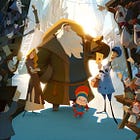
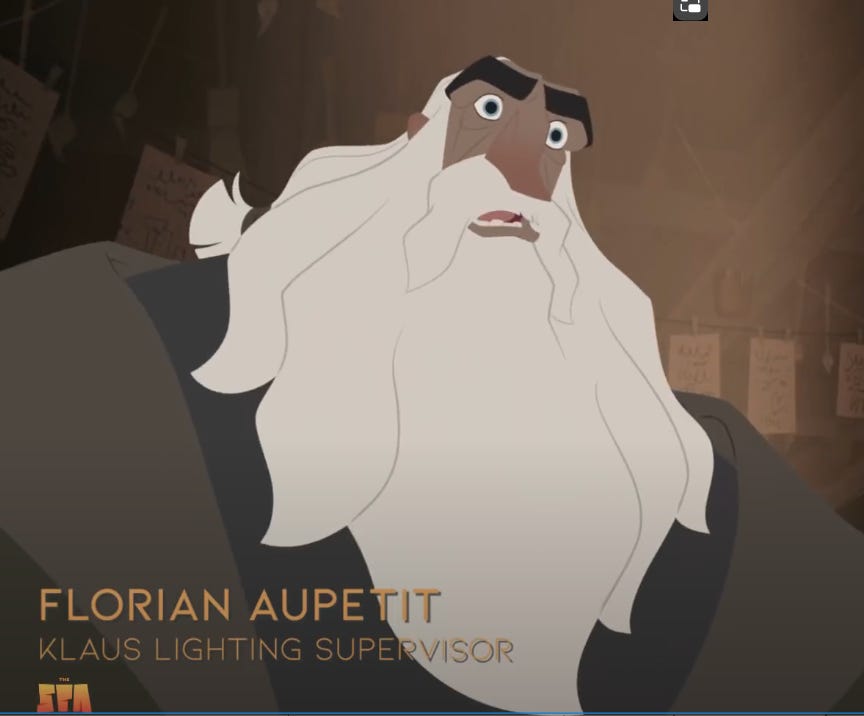


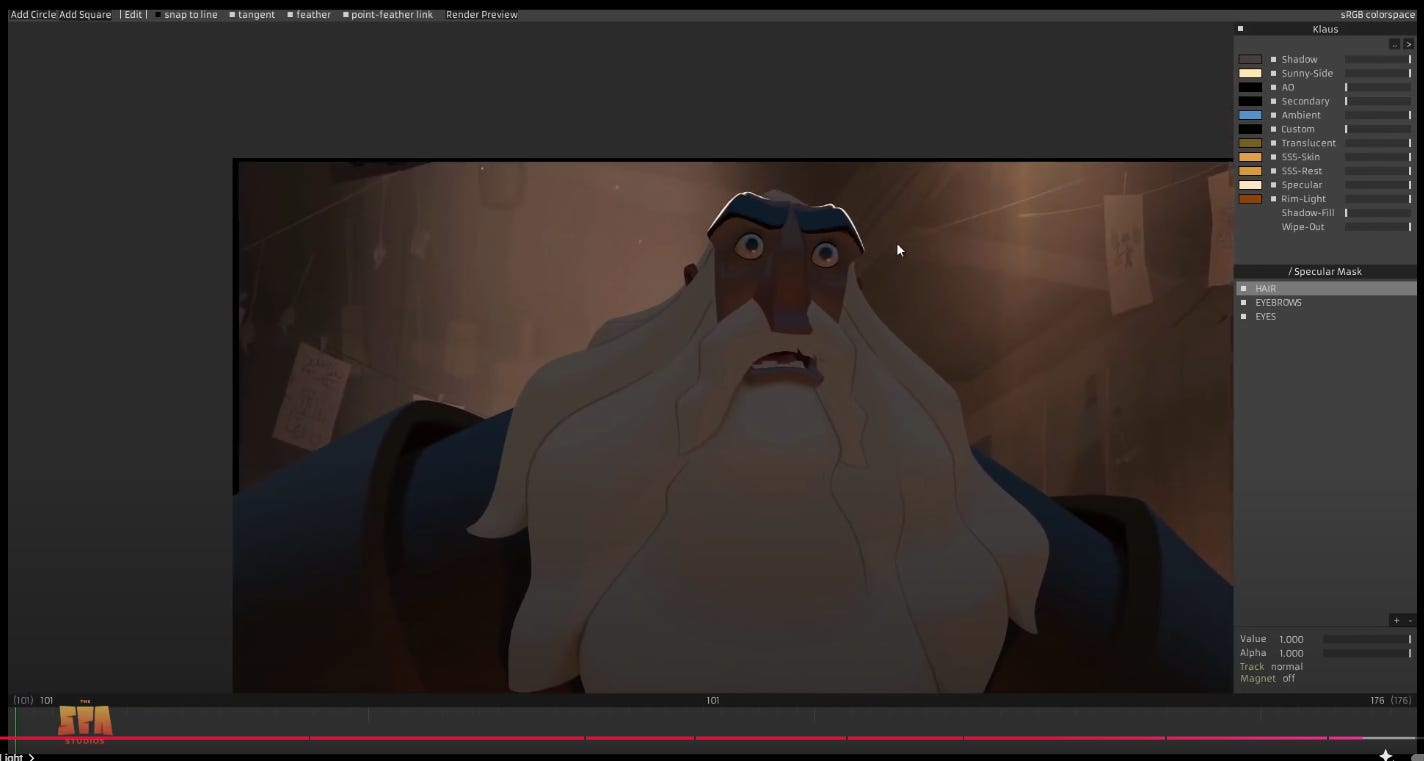

Never thought of looking at Klaus this way. Really loved the article Francisca and will look very differently at every movie now.
And yes, good things take time...
Again Francisca. Great post.